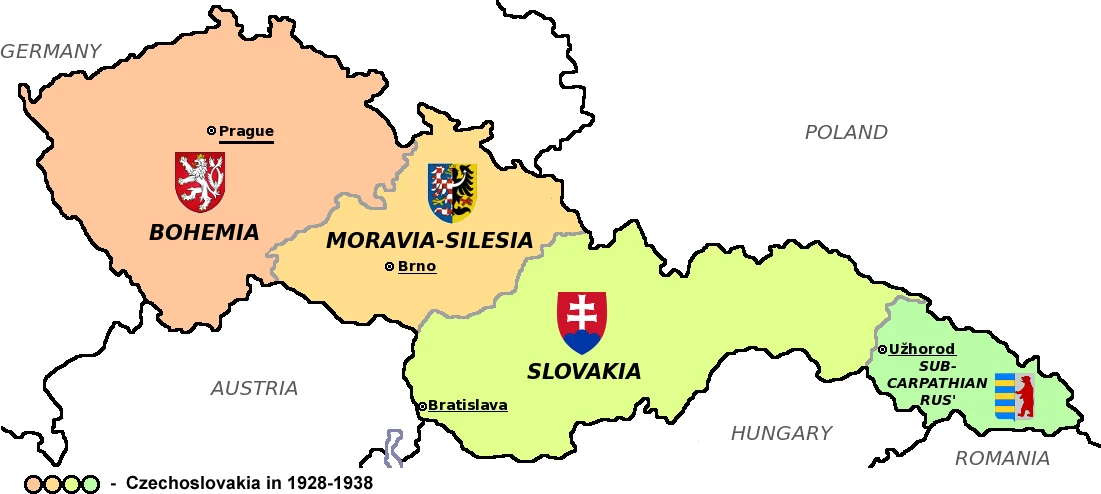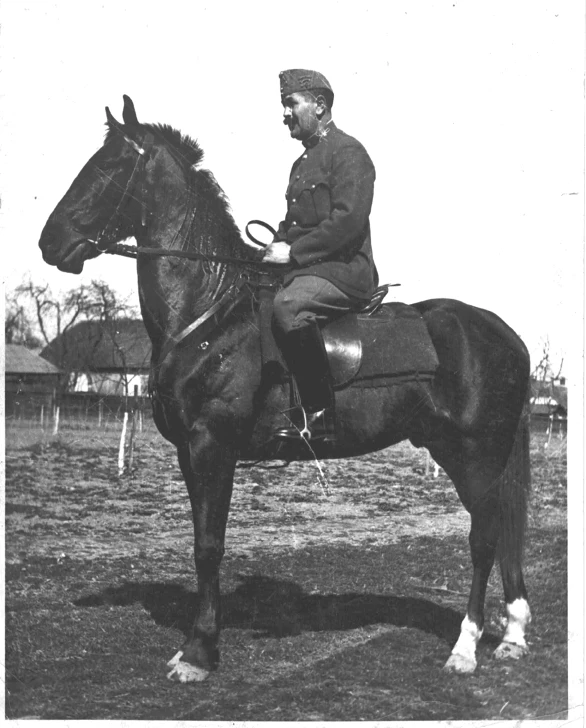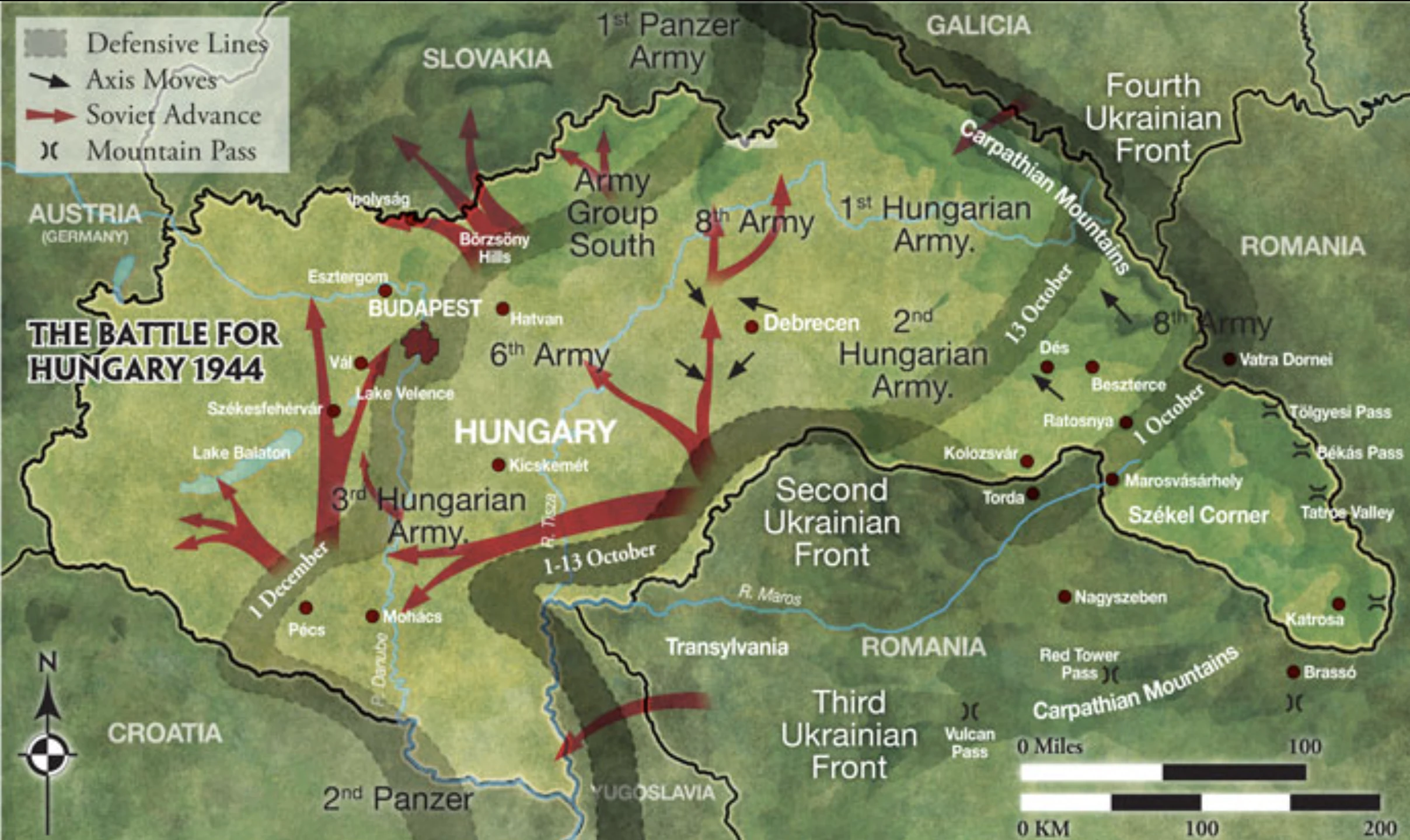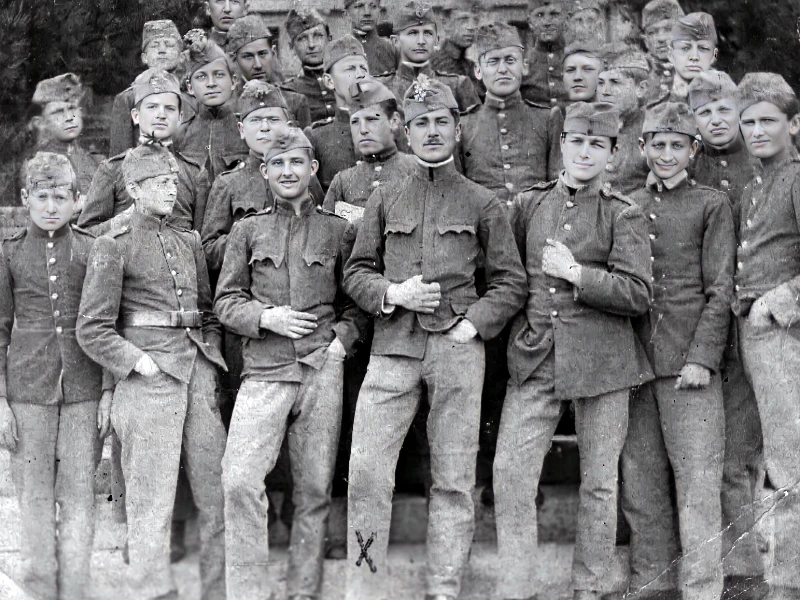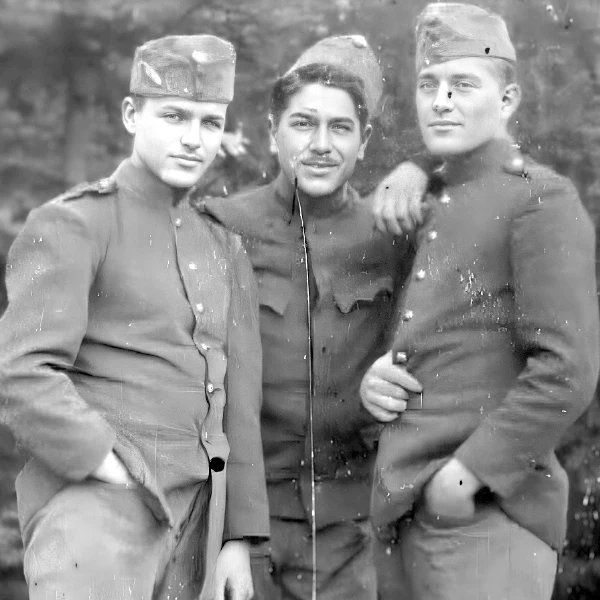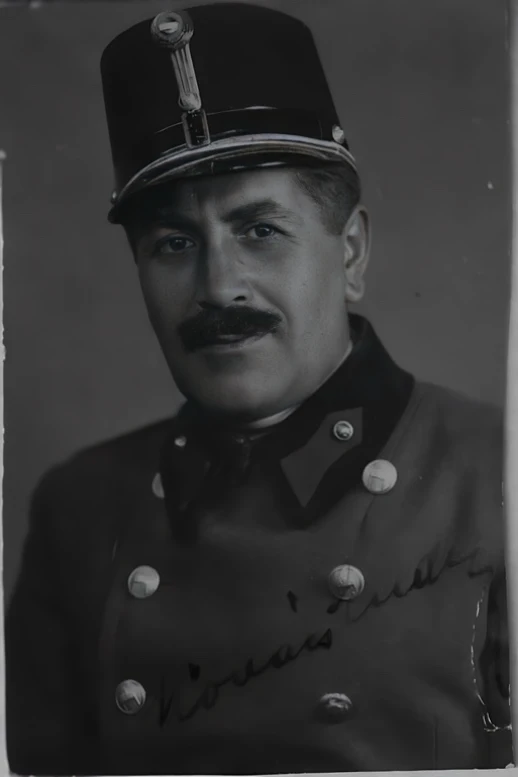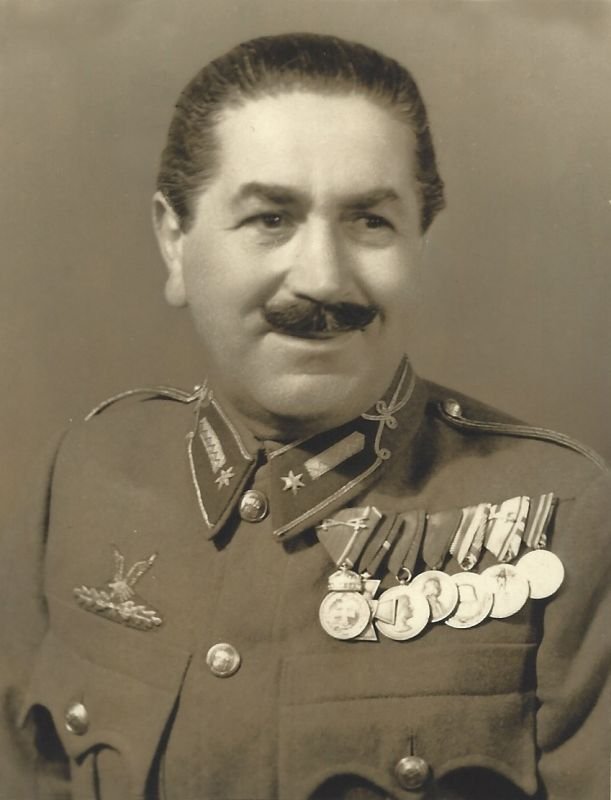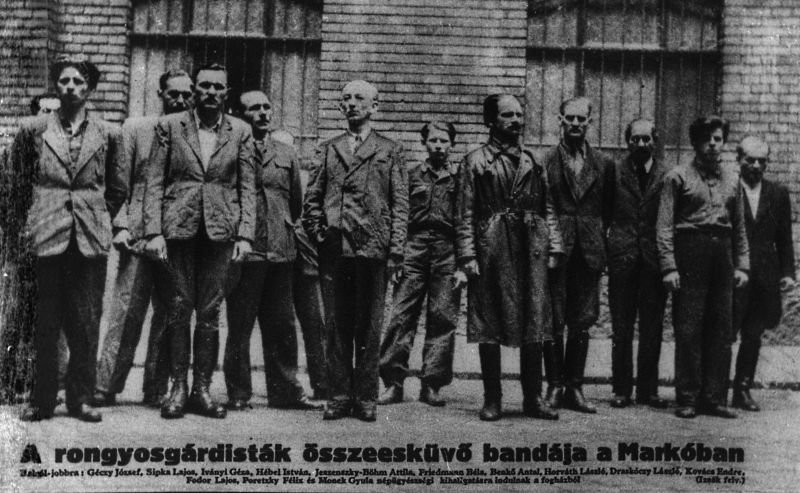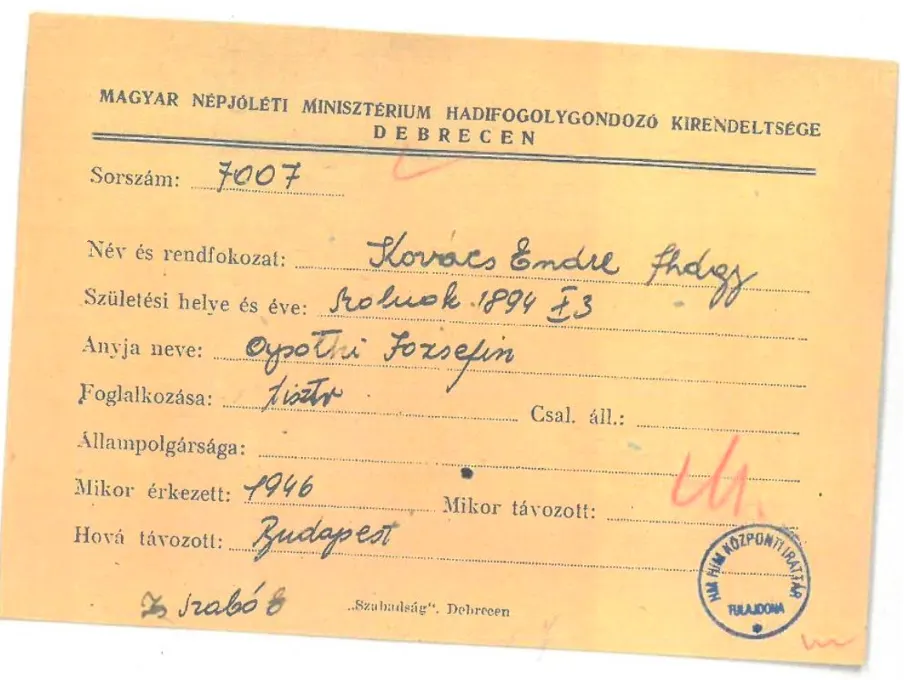1st Lieutenant Endre Kovacs (Hungary WW2) Military Career
Kovács Endre (born: Szolnok, 3rd June 1901 – died: Budapest, 31st March 1949).
Endre is remembered as a patriot in Hungary, recognised for his role in defending the country during World War II. His legacy is a testament to his dedication and service to Hungary.
Kovacs’ military career spanned over two decades, during which he rose through the ranks to become a prominent figure in the Hungarian Army. It’s clear that Endre Kovacs’ patriotism and dedication to Hungary are significant aspects of his legacy. His story serves as a reminder of the complexities of history and the importance of understanding the contexts in which people lived and made decisions.
In summary, he graduated from military school. In 1938, joined the Ragged Guard as a reserve lieutenant and was later promoted to reserve first lieutenant. By the end of WW2, as a first lieutenant and intelligence officer, was one of the key military leaders responsible for implementing Hungarian Defence Plan 3 (Def-3). He worked closely with other Hungarian military officers to coordinate the defense of Hungary against the Soviet Army’s advance coordinated at the Hungarian Budapest Siege breakout. https://kitores45.hu/katonahoseink/kovacs-endre-fohadnagy/#English
According to the History Institute & Museum – Archive of Military, belonged to the 5th Division of the Chief of the Hungarian Army General Staff, the Ragged Guard (Rongyos Gárda) played a crucial role in the territorial conflicts, especially in the reoccupation of territories lost by Hungary after World War I.
The Ragged Guard which Endre Kovacs was a member of back in 1920s, is an irregular unit (para-military) of the Hungarian Royal Army, that had around 500 men in October 1938, as reported by CNE503. The unit was deployed in phases between October 1938 and March 1939, with distinct objectives, including reconnaissance, infiltration, and local skirmishes. The Ragged Guard was renamed “Map Correctors” and “Weather Forecasters” between November 1938 and March 1939, engaging in propaganda and minor skirmishes. I cover “Map Corredctors” later.
Kovács Endre graduated from Hadaprodikáló Military School in Hungary. Sadly the school does not exist anymore. It operated during the interwar period, specifically from 1923 to 1945. After World War II and the political changes in Hungary, the school was disbanded and did not continue its operations.The term “Hadaprod Iskola” refers to belonging to Honvéd Hadapród Iskolák, that is, military preparatory schools in Hungary. These schools were established based on the 1897 law to train officers, particularly non-commissioned officers, for the Hungarian military.
1921 : As Ragged Guard member, Kovács Endre was a Budapest official and later a reserve first lieutenant. In 1921, he took part in the uprising in Western Hungary. As a civilian, he was an economic inspector.
The Ragged Guards (Rongyos Gárda) fought against Austrian forces and local militia units in the region of Sopron during the conflict over the status of Western Hungary, also known as the Burgenland. This was part of a series of skirmishes and guerrilla actions aimed at preventing the incorporation of Western Hungary into Austria, following the Treaty of Trianon. Their efforts were aimed at keeping Sopron and its surrounding areas under Hungarian control. The successful resistance by the Ragged Guards and local Hungarian militias led to the Sopron plebiscite in December 1921, where the majority of the population voted to remain part of Hungary.
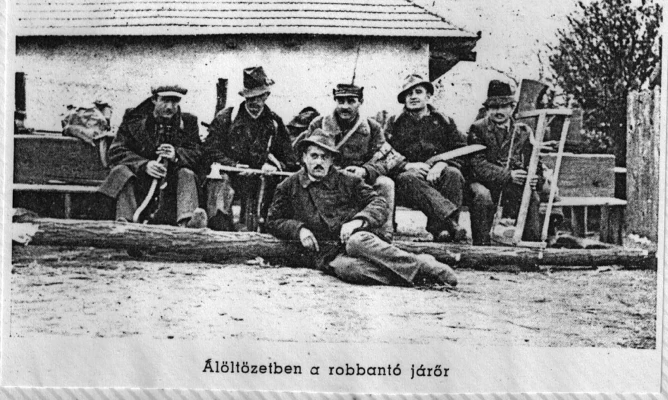 Ragged Guards in 1920s Endre as a Paramilitary Unit Member leaning against trunk
Ragged Guards in 1920s Endre as a Paramilitary Unit Member leaning against trunk
After a short military service in 1927, he was promoted to reserve ensign.
He During peace time, Endre was an official in the capital becoming a tax enforcer at the Tax Office, then a supervisor in the Danube Inspectorate, and later a chief supervisor.
In 1937, he was a hospital officer at the capital Budapest.
According to History Institute & Museum Archive of Military, Endre Kovacs records workded as a civil servant between 1939-1944, but there are no records from this period. In 1941 shows hum as a hospital administrator and also worked for the National Free Port and Shipping Company.
From a primary source (Andras Kovacs – son): During peace time, Endre was an official in the capital Budapest becoming a tax enforcer at the Tax Office, then a supervisor in the Danube Inspectorate, and later a chief supervisor.
He was a hospital officer at the capital Budapest.
Goals of Hungary Government
Horthy government saw this time to regain Transcarpathia. To prepare for this, Horthy used the diversionary activity of the Ragged Guard, a paramilitary group.
The Ragged Guard played a crucial role in the territorial conflicts, especially in the reoccupation of territories lost by Hungary after World War I.
Endre Kovacs’s role at the start of World War II were intertwined with Hungary’s territorial losses following the dissolution of the Hungarian Kingdom after World War I, particularly due to the Treaty of Trianon.
His activities at his mature age of 37, in 1938 played an important role as a member of the Ragged Guard in Subcarpathia.
map correcting section of the Elöd battalion stationed in Tiszaujhely,
On 2 November 1938 , in accordance with the First Vienna Decision, Hungary regained from Czechoslovakia the Hungarian-majority part of the country along the Trianon border, including Tiszaújlak.
Under the direction of former Interior Minister Miklós Kozma (at that time President and CEO of the Hungarian Telegraphic Office, later Governor of Transcarpathia), Endre participated as one of the group leaders (under Vannay) of the reorganised (second) Ragged Guard in the Transcarpathian diversionary operation, which prepared the reoccupation of Transcarpathia which was once part of Austria Hungary before WW1..
Lieutenant Endre Kovács was the commander of the Map Correcting Section of the Elöd battalion stationed in Tiszaujhely, created during the reorganisation of the Ragged Guards. His department had a total of 6 people. (Source: ÁBTL 4.1. A-653/3. page 270). The area was reclaimed by the Map Correction Section..
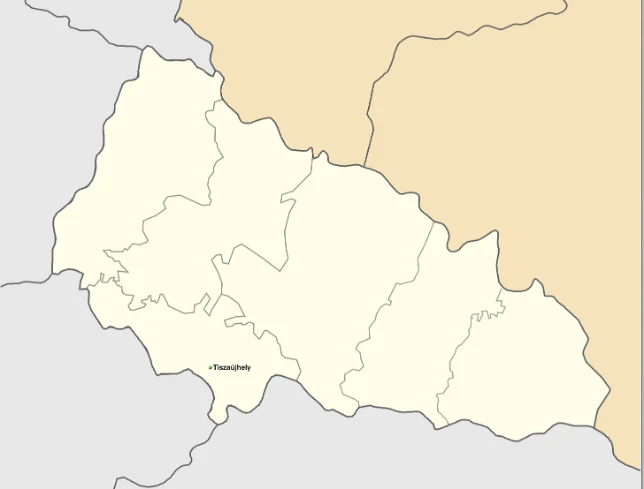
Today, Tiszaújlak ( Ukrainian: Fork [Fork], in Slovak: Výlok, in German :Wylok) is a rural settlement in Transcarpathia , Ukraine
The role of Time Signalng Service (according to Chat GPT)
In November 1938, the Home Guard’s Time Signalling Service in Hungary played a crucial role in ensuring accurate and synchronised timekeeping across military and civilian operations. This service was vital for coordinating activities, particularly in an era when precise timing was essential for communication, transportation, and military movements.
Key roles and responsibilities of the Home Guard’s Time Signalling Service included:
1. Time Synchronisation: Ensuring that all military units and important civilian institutions had synchronised clocks. This was critical for coordinated operations and avoiding miscommunication.
2. Distribution of Accurate Time: Providing the official time to various sectors, including transportation (railways, postal services), government offices, and military units. This often involved the use of telegraph and radio signals to disseminate the accurate time.
3. Maintenance of Timekeeping Instruments: Regularly checking and calibrating clocks and other timekeeping devices to ensure they remained accurate.
4. Coordination with National and International Time Services: Liaising with national observatories and international timekeeping bodies to maintain the accuracy of the local time standard.
5. Training and Oversight: Training personnel in the proper maintenance and use of timekeeping equipment and overseeing the implementation of time synchronization protocols.
In November 1938, given the geopolitical tensions in Europe, these services were even more critical as they supported both civilian life and military readiness.
There were a number of companies.
On November 14, the “time signal service” began its propaganda activities. In the process, transportation and communications were disrupted and leaflets were distributed in the Ruthenian area.
The 1. Time marking group: Vannay hdgy. Under his command, 2/3rds of the 2nd company went to Tiszakeresztúr, which is where Ensign Endre Kovacs set up the No. 1 time signalling station (one squadron) in Tiszaújhely, and the No. 2 signalling station (one squadron in Sálanka. There were other time keeping groups as well but is outside the scope of my research. Miklos Kozma was informed of several fighters being treated in the city hospital.
In November 1938, the Home Guard’s Time Signalling Service in Hungary played a crucial role in ensuring accurate and synchronised timekeeping across military and civilian operations. This service was vital for coordinating activities, particularly in an era when precise timing was essential for communication, transportation, and military movements.
The 1. Time marking group: Vannay hdgy. Under his command, 2/3rds of the 2nd company went to Tiszakeresztúr, which is where Ensign Endre Kovacs set up the No. 1 time signalling station (one squadron) in Tiszaújhely, and the No. 2 signalling station (one squadron in Sálanka. There were other time keeping groups as well but is outside the scope of my research. Miklos Kozma was informed of several fighters being treated in the city hospital.
Period 4 (November 8-19, 1938); Enterprise across the new border propaganda activity
For the reasons of concealment, it was expedient for the organisation to march in uniform and take the name HOME GUARD TIME SIGNALLING SERVICE.
On November 14, the “time signal service” began its propaganda activities. In the process, transport and communications were disrupted and leaflets were distributed in the Ruthenian area.
On November 10, 1938, as a member of the Ragged Guard, Endre according to the trial, took part in the invasion of the highlands, and was the commander of the Tiszaújhely division that entered. In Tiszaújhely and Tiszaújlak, He is accused of allegedly participating in the torture and unlawful execution of at least three Czechoslovak citizens accused of espionage, anti-Hungarian activities
Period 5 (November 19, 1938- December 12 1938)
Arch to the general attack, transformation into correction bodies)
The Vannay group (with five swarms of 10 people each) attacks on a wide front between the Tiszaúlak, Nagyszÿlÿs railway and the Tisza and takes possession of Nagyszÿlÿs.
Vannay had already carried out reconnaissance of the attack area beforehand and organised weapons and some 150 people behind Czechoslovak artillery positions at 6pm. Vannay also delivered sleeping pills and poison to be used against the Czechoslovak garrison on the 21st. The attack failed. On November 24, a covert propaganda organisation was created with the addition of the “time signalling service” under the new code name “map correction service”
MAPPING –Period 6 (December 13, 1938–March 13, 1939): propaganda activity, border incidents
On December 15, the command and supply bodies carrying out the local liquidation and
event recording returned to Budapest. Here they started liquidation under the name “technical office. “liquidation” typically means the process of closing down operations, possibly involving the disposal of assets, settling debts, and documenting everything for record-keeping purposes. The term “technical office” might have been used to provide a formal or less conspicuous label for the group handling these tasks
On January 6,1939 the most serious border incident took place on the Czechoslovak – Hungarian border at Munkác. A total of 97 people from the staff of the Map Correcting Directorate came to Munkács, and 1/3 took an active part in the strike.
Using Chat GPT states: “Lieutenant Kovács Endre and his unit from the Ragged Guard were indeed involved in an attack on Munkács on January 6, 1939. This action was part of the broader Hungarian efforts to control the region amid the political instability in Czechoslovakia. The Ragged Guard’s activities in this period are documented in various military reports and historical accounts.”
Using Google Translate and ÁBTL 4.1 A-653/3 Page 270 : Hungarians are reduced to a minority in the settlement – was also occupied by a 6-member combat group of the map correctors led by Lieutenant Endre Kovács and was commander of the Elö Battalion from March 14 to 15 1939 in the early hours of the night, and held the settlement until the arrival of the army in the early hours of the morning.13 The map correctors also played a role in the occupation of the village of Verbÿc – one of their staff was wounded here – and the local national guards they armed. One of the latter was killed (from shrapnel from a poorly thrown hand grenade). After that, on the afternoon of the 15th March, another map correction group of 16 people was deployed at Tiszaszász Village to support the defenders fighting there, and took part in the capture of the village. After that, the group from Beregszász on the left wing, the map correctors took part in the occupation of several more villages, but now without any meaningful fighting.
Period 7 (March 14 – March 18, 1939): Participation in the annexation/reunification of Subcarpathia
Fancsika itself as a town, was still a Hungarian majority at the time, but “today” the Hungarians are outnumbered in the settlement”.
The Vannay battle group which ensign Endre was part of his squad, was tasked with securing the village of Fancsika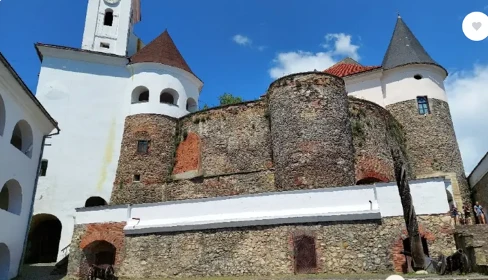
(Fanchykovo in Ukrainian:Hungarian: Fancsika), which was a strategic location in the Carpatho-Ukraine region. Lieutenant Endre Kovacs led a 25-man battle group of map correctors in a skirmish against Ukrainian forces at Fancsika (now Fanchykovo, Ukraine – Appendix), on March 15, 1938 encountered resistance and a brief but intense battle ensued. “He held the settlement on the night of the 14th to the 15tth, until the arrival of the army (National Guard) in the early hours of the morning.” Although outnumbered, Lieutenant Kovacs’ battle group managed to gain control of the village Fancsika, and the Ukrainian forces retreated. The success of this operation was seen as a significant morale boost for the Hungarian forces, and Lieutenant (AI also uses the term Ensign) Kovacs was praised for his leadership and bravery.
“Hungarians are reduced to a minority in the settlement – was also occupied by a 25-member combat group of the map correctors led by ensign Endre Kovács from March 14 to 15 in the early hours of the night, and held the settlement until the arrival of the army in the early hours of the morning. The map correctors also played a role in the occupation of the village of Verbÿc – one of their staff was wounded here – and the local national guards they armed. One of the latter was killed (from shrapnel from a poorly thrown hand grenade). After that, on the afternoon of the 15th, another map correction group of 16 people was deployed at Tiszaszász Village to support the defenders fighting there, and took part in the capture of the village. After that, the group from Beregszász on the left wing, the map correctors took part in the occupation of several more villages, but now without any meaningful fighting.
None of the map correctors fell in the March battles, and the already mentioned national guard from Verbÿc is the only local Hungarian resident that I have invented, equipped by them, who fell in the battles (he too from his own weapon, not due to enemy influence).”
Period 8 (19 March -7 July 1939): Reconnaissance, pacification and annexation
Ensign/ Lieutenant Endre Kovacs’ actions during the Hungarian annexation of Carpatho-Ukraine in 1938-1939. involved in the destruction of the bridge over the Latorca River (now Latorytsia River) in the town of Berehovo (now Berehove, Ukraine) in March 1939.
The bridge was an important transportation link between Hungary and Carpatho-Ukraine, and its destruction was a strategic move by the Hungarian forces to hinder the advance and retreat of Ukrainian and Czechoslovakian troops.
The destruction of the bridge by Endre Kovács and his unit was a significant tactical move, disrupting enemy logistics and facilitating the Hungarian advance.” Ensign Kovacs, as a member of the Vannay group, played a role in the demolition of the bridge, which was a key moment in the military campaign. Latorytsia and Latorica refer to the same river
Lieutenant Endre Kovács was the commander of the map correcting section of the Előd battalion stationed in Tiszaújhely, created during the reorganization of the Ragged Guards. The department had a total of 6 people. (Source: ÁBTL 4.1. A-653/3. page 270)
Kovács Endre’s activities during these years were part of a broader effort by the Ragged Guard to support Hungary’s revisionist aims and reclaim lost territories through paramilitary and military means.
In November 1938, the Home Guard’s Time Signalling Service in Hungary played a crucial role in ensuring accurate and synchronised timekeeping across military and civilian operations. This service was vital for coordinating activities, particularly in an era when precise timing was essential for communication, transportation, and military movements.
The Ragged Guard, an irregular unit (para-military) of the Hungarian Royal Army, had around 500 men in October 1938, as reported by CNE503. The unit was deployed in phases between October 1938 and March 1939, with distinct objectives, including reconnaissance, infiltration, and local skirmishes. The Ragged Guard was renamed “Map Correctors” and “Weather Forecasters” between November 1938 and March 1939, engaging in propaganda and minor skirmishes.
As the commander of the Map Correcting Section unit in Tiszaújhely and Tiszaújlak in 1938, Lieutenant Kovacs Endre was responsible for coordinating the transfer of his units in the Elöd battalion of 11 people (Source: ÁBTL 4.1. A-653/3. page 270) across the border and launching attacks against Czechoslovak targets to support Hungary’s irredentist claims on Czechoslovak territory and to disrupt the country’s stability.
Endre was accused in the Hungarian INTERROGATION BY PEOPLE’S PROSECUTORT’S OFFICE OF ENDRE KOVACS – MARCH & APRIL 1948 which lead to his execution, that he also blew up a bridge. According to WhatsApp AI and other sources:
“Ensign Endre Kovacs’ actions during the Hungarian annexation of Carpatho-Ukraine in 1938-1939. involved in the destruction of the bridge over the Latorca River (now Latorytsia River) in the town of Berehovo (now Berehove, Ukraine) in March 1939. The bridge was an important transportation link between Hungary and Carpatho-Ukraine, and its destruction was a strategic move by the Hungarian forces to hinder the advance and retreat of Ukrainian and Czechoslovakian troops.
Ensign Kovacs, as a member of the Vannay group, likely played a role in the demolition of the bridge, which was a key moment in the military campaign. Latorytsia and Latorica refer to the same river”
Fighting side by side in the battalion were veterans of the first World War and boys of high school age. The core was provided by former members of the “Ragged Guard (Endre Kovacs)” workers from the Budapest municipal services, fireman, sewage, water supply, electricity and to telephone linesman, middle aged men who have seen the battle of the Eastern Front fought along refugees from Transylvania and street wise youngsters from the slums of Újpest.. They were thrown into battle after three to six weeks of accelerated combat training and perfected their fighting skills by practicing on the enemy.
The “Hungarian Defence Plan 3” (also known as the Huba III Plan) was a strategic military directive developed by the Hungarian General Staff during the winter of 1944–45. Its primary objective was to establish a defensive line along the Danube River to protect Budapest and the western regions of Hungary from the advancing Soviet and Romanian forces. This plan was formulated in response to the deteriorating military situation as the Axis powers faced significant setbacks on the Eastern Front.Wikipedia
Context and Strategic Objectives
By late 1944, Soviet forces had encircled Budapest, initiating the Siege of Budapest on 26 December 1944. In an effort to relieve the besieged city and reclaim the Transdanubian region, the Germans launched Operation Konrad III on 18 January 1945. This operation aimed to break the Soviet encirclement and retake the western part of Hungary .Wikipedia+1Wikipedia+1Wikipedia
Execution and Outcome
Despite initial surprise and some tactical successes, Operation Konrad III ultimately failed to achieve its objectives. The Soviet forces, reinforced by Romanian units, mounted a vigorous counteroffensive, leading to heavy casualties on both sides. The Hungarian forces, already weakened and undermanned, struggled to maintain their positions.Wikipedia+4Wikipedia+4Wikipedia+4Wikipedia
Following the failure of Operation Konrad III, the German and Hungarian forces attempted to regroup and establish new defensive lines. However, the Soviets continued their advance, and Budapest fell on 13 February 1945 . Subsequently, the Soviet forces pushed westward, and Hungary was effectively liberated by early April 1945.Wikipedia
Legacy
The Hungarian Defence Plan 3 reflects the desperate measures taken by Hungary and its Axis allies to stave off the Soviet advance in the final months of World War II. Despite the plan’s failure, it underscores the strategic importance of Hungary in the broader context of the Eastern Front and the determination of its military leadership to defend the homeland against overwhelming odds.
DEF3 as a Counterintelligence Directive
Given Lt. Endre Kovács’ known role in Hungarian military counterintelligence (V-Section, under Captain István Szekeres), “DEF3” might denote a third-tier security clearance protocol or operation, such as:
DEF1 – Internal troop surveillance
DEF2 – Anti-partisan activity and domestic agent checks
DEF3 – External counter-espionage against Soviet infiltration
26 December 1944 by the Red Army and the Romanian Army. During the siege, about 38,000 civilians died.
The Battle of Budapest, also known as the Siege of Budapest, was a pivotal 102 day military operation during the final stages of World War II, in which Soviet and Romanian troops encircled Hungary’s capital city.
14 Feb 1945 the last phase of World War II and 102/50 days of the siege of Budapest resulted in the loss everything. 1st Lieutenant Endre Kovacs was captured and wounded. He was sent to a POW camp, the soviets returned him to Hungary where he fell in the hands of the vengeful anti-fascist people’s tribunals and was condemned to death like many others comrades including the physician Dr Mihály Kádár , the medical student Bilkey Pap, etc
The city unconditionally surrendered on 13 February 1945.
Captain Blajziath: We have reached battalion strength with more than 600 enlisted men. from now on we are no longer to be referred to as a detachment but as the R.H.Army Vannays Battalion.
In the afternoon I receive a visit from Lieutenant Kovács Endre with a number of elderly intelligence officers from Def 2 in an elegant DKW (car). and your priority task has been assigned to all volunteer units of the Arrow Cross Commission Commissar for Budapest; razzias (hostile raid) must be carried out to round up all AWOL and spies. Support police regiment is deployed as Infantry.
By now 1st Lieutenant Kovács has arrested 2 false lieutenants and now he’s looking for an imposter who claims to be a Vannaist spreading confusion in the Leopold District.
Danube “Dip” Kovács Style
11 December Budapest, Toddy
The long range artillery pummelling of Pest seems to have ceased. Our Air Force must have bombed out the Soviet batteries.
1st Lieutenant Kovacs brings in two dripping wet civilians and locks them into the coal shed of the Basement. They are Vannaist deserters .The Proclamation of General Hindy has just been posted with orders to disembowel all deserters on the spot! instead Kovacs made them dip into the ice called Danube. I kept pulling there ears a bit until they ask for parden. Ervin states “ I cannot but admire Kovacs good humid interpretation of the disembowelment order. Deserters must be chastised not wasted”.
15 December 1944 – Extract from the book Boy Soldier Page pg 58.
“Friday 1st snow, Bohn Factory one night in a battalion dormitory. A motorcyclist drives me Irving to the Bohn factory in Obuda. I report to 1st Lieutenant Kovacs and he refers me to sergeant Lovass. The sergeant takes the trouble to instruct me in the Vannay tactics of urban combat outlined below:
- two men form a pair but the smallest tactical unit is a squad of four men this is based on the bácsi system. This means that three young volunteers are assigned to an older veteran or uncle who is personally responsible for their training and subsequent survival.
- in an attack or Defense, the squad moves in the diamond pattern. the point man is a lightweight youngster armed only with pistol and grenades. he is followed by the left wing and right wing rifleman and with machine pistols and by the “uncle” as rear guard carrying a sniper gun or a Panzerfaust RPG
- the point man is first to enter a tunnel or a cave or room or to climb up on a lightning rod or gutter to the roof then pulls up the other team members and their gear
- retreating, the uncle as the rear guard unless he is hit, if wounded, the youngsters are needed to drag him back then with the point man acting as the rear guard
- with the exception for reconnaissance missions, the raids are carried out by a half-platoon of 16 men in quadruple diamond formation. The last squad of the half platoon carries an mg42 machine gun or a 50 millimeter motar. in a mortar platoon each men has to carry two bombs in addition to the other weapons. the machine gun platoon’s must carry belt full boxes of ammunition each box-wise 13.5 kilograms!
- attacking a multi-storey building the first squad secures the roof, the second penetrates the basement Squad 3 the first floor Squad 4 the second floor. In the case of a tall or heavily defended building, further half platoons are deployed in successive waves up to 64 to 80 men which is the average combat strength of a company
- the combat course is about 200 meters long the length of a city block. the first task is to scale one of the long sheds of the brick factory and to advance riding on the ridge then rapple down. The next section is a large concrete pipe, have flooded which has to be crossed by Seal wiggling
- emerging from the pipe the team is confronted with a t34 carcass tank and must lob a grenade toward it from a distance of 30 meters then jog alongside the tank. Next the uncle fires a small Panzer faust towards a brick wall from 15 metres. The Rifleman fire at cardboard targets moved by small pulleys like stage sets in a theatre
returning, the point man must jump up on the tank, run over the turret, jump down and take up the position of rear guard while the uncle assumed to be wounded, is dragged through the tunnel and along the brick drying sheds back to the starting position.
Extract from book “Boy Soldier” Soviets POW 3rd of February P 161
The metal door into the next room opens. Corporal Váli is bringing in two hooded handcuffed Soviets. he removes the Hoods made of pillowcases. there is a tall cleanly shaved Officer and a slit-eyed Bodyguard type probably Uzbek, copiously bleeding from the lips and nose.
First Lieutenant Kovacs is contacted by phone DEF3 special phone line works impeccably. Sir! Corporal Váli brought in some Red Army brass. Whats next? Kovacs reply: I’m sending Ensign Párlházi and he will the be there in the jiffy. Párlházi arrives and orders everyone to leave the room and leave him with the prisoners; finally the Lieutenant calls for Corporal Pálházi to take these men back to the institute and release them unhurt, they are now my carrying pigeons.
# Role in Def-3
Kovacs was one of the key military leaders responsible for implementing Def-3. He worked closely with other Hungarian military officers to coordinate the defense of Hungary against the Soviet Army’s advance.
Hungary’s Defense Plan 3, also known as “Védelmi Terv 3” or “Def-3,” was a military plan developed in 1945.
# Purpose
Def-3 aimed to defend Hungary against the Soviet Army’s advance during the final stages of World War II.
# Key Components
– Focused on holding key terrain features, such as the Danube River and major cities
– Employed a combination of regular army units, militia, and volunteer forces
– Incorporated guerrilla warfare tactics to harass and disrupt Soviet supply lines
# Outcome
Despite the efforts outlined in Def-3, Hungary was ultimately unable to withstand the Soviet onslaught. Budapest fell to the Soviets in February 1945, and Hungary was fully occupied by the end of April 1945.
An interview between Ervin Galantáy and Colonel Sándor Nyisztor in 1968 explained in his book by the Colonel the function of DEF: These groups were out there with attempts at deception and masquerade. There was no other unit in the Hungarian Army to have such an efficient intelligence counterintelligence unit; at battalion level ; the use of Russian speaking volunteers was a unique idea and also the attempts at subversion and disinformation. Even more could have been done since that battalion dispose of so many trained signals professionals, reservists employed by the Post Office
Background: The Red Army deported between 360,000 and 400,000 Hungarian Royal Army soldiers and between 200,000 and 240,000 civilians of Hungarian nationality to labor camps in the Soviet Union from September 1944 until the middle of 1945.
A further 300,000 Hungarian Royal Army soldiers fell into U.S., British and French captivity in the spring of 1945. All of these soldiers returned to Hungary by the summer of 1946. Life in the camp everywhere meant misery, vulnerability, hopelessness and mass death.
Soviet officials began authorising the release of Hungarian prisoners of war only after the conclusion of the Treaty of Peace with Hungary in February 1947, repatriating 100,288 Hungarian POWs by the end of the latter year, 84,310 in 1948 and around 215,000 more over the subsequent few years.
Therefore, around one-third of the roughly 600,000 Hungarian Royal Army soldiers and civilians of Hungarian nationality that the Red Army deported to the Soviet Union in 1944 and 1945 never returned to Hungary and are presumed to have died in captivity (source in Hungarian http://www.hadifogoly.hu/web/hadifogoly/page6).
Endre was as a captured war prisoner at the siege of Budapest in 1945, was sent to Uszmány, a Russian Prisoner Of War camp settlement 65 km northeast of Voronezh, the Voronezh-Gryaz railway line along.
Soviet POW for 18 months
THERE WERE 2 POW CAMPS POST WW2 THAT HE WAS INTERNED IN.
The registration form of POW Camp No. 95 in Uszmány (Usmanь), and of the POW branch of the Ministry of Public Welfare in Debrecen, after his return home, both show his date of birth as 1894.
“As stated in our latest case file HHI/276-2/2024. nyt. in the case in question, no data relating to the person of your grandfather, the late Endre Kovács (Szolnok, 3 June 1901 – Budapest, 31 March 1949), in connection with his Soviet prisoner of war service – based on the year of birth 1901 – can be found in the databases created by the HM Institute and Museum of Military History and the Hungarian National Archives, which are available online.
Using the Hungarian National Archives’ database entitled Hungarian Prisoners of Soviet Camps, Endre Kovács (identity number: HU MNL OL X 10874), referred to in the present petition, was given as having been born in 1894. The birth years
The significant difference in the birth years precludes a clear identity match.
However, other personal (place of birth Szolnok in both cases) and military (reserve service)
lieutenant/lieutenant rank), we have conducted further research in the registry entries available on the Family Search interface to determine whether any relationship or possible kinship connection can be established between the two persons.” This is the birth date of Endre’s younger brother that died at birth in 1894.He returned home from the Uszmány officers’ prison camp in 1947, weighing only 45 kilograms.
DIARY BELOW
Dairy of Kovács Endre
Number of Pages intentionally left out.
1945 EDESAPAM EMLEKERE.
Page 2
TROUBLE
1945
Saturday, March 10.
Bean soup for breakfast at 1/2 5 o’clock after the alarm clock. I got to Barber early. Corn grits for lunch. I ate the dose today. Gyurkica’s illness is improving. Tompos got worse. I got an egg by accident. Tompos got worse again. We got bitter tea at 3 p.m. I am getting better, yes I am hungry, the weather is getting better, there is no wind or snow. We were disinfected.
Sunday, March 11.
They promised a Mass, but it was missed. A wake-up call “only” at 4 a.m., Sunday, a holiday, does not count for the prisoner. Corn grits for breakfast and lunch, hunger is the master. I would give P100 for a chick’s pasta. I think about home a lot.
Monday, March 12.
After a wake-up call, we were given corn for breakfast at 3/4 5 o’clock. My health is quite good. Tompos is also improving. We would like to buy something from the davaj, but it is not possible. Rumors are circulating that we are going home. Corn grits for lunch. My frozen hands feel cold. Gyurkica Bandi is getting better.
Tuesday, March 13.
After the wake-up call, the breakfast was varied, we got bean soup. He didn’t even see me eating breakfast this early. Many people start fattening from millet. We eat like pigs. I am very hungry all the time. I bought an egg today, I’ll eat it tomorrow if I don’t satisfy my hunger that night. I gave Antalfy a 7 dc bottle, he was happy, he already used it that night.
Wednesday, March 14.
The weather has eased. We got corn for breakfast. Yes, we are hungry. They are supposed to take me on the 18th, we don’t know where. At 12 o’clock at 12 o’clock at 12 o’clock, they gave a new meal. There is no dinner. Gyurkica is fine, Tompos is improving rapidly. I’m waiting for a good time to do a load of laundry. Today is a holiday. My coma is painting, it will be ready tomorrow.
Thursday, March 15.
Even on our national holiday, the alarm goes off at 4 o’clock, and corn is served for breakfast. Number reading. Lunch 3/4 at 12 noon, also corn meal. D. u. At 4 o’clock we were given tea without sugar. All my thoughts are to see you just one more time. The picture was not completed because the paint was not ready. Maybe tomorrow.
Friday, March 16.
Cornmeal for breakfast, same for lunch. The frostbite is getting better on my face and legs. There is really bad news that we are really going to Ukraine. I really want to see you just once. There are 18 dead. Two typhoid fevers, 2 pcs. Today they wrote a list again without an apartment. I was out 3 times that night.
Saturday, March 17.
Today we had boiled eggs for breakfast, I couldn’t eat them. We had bean soup for lunch. I think about you a lot, I don’t even know what will happen to you. I don’t have much left. I could only hug you and my little boy one day. We await fate. I hope I get home.
Sunday, March 18.
Alarm clock still at 4 a.m., breakfast bean soup, d.e. we were in disinfection. Lunch is also bean soup, d.u. Bitter tea at 4 o’clock. My health improves a lot from the sugar, 35 grains 100 pengő, I will try to buy again tomorrow if I succeed. Then there will be no money-.-? My health is almost
Page 3
perfect, I’m starting to get my school back, if not the old one, but something. Yes, I long for you. Indeed, our days are numbered. We are in God’s hands.
Monday, March 19.
We had bean soup for breakfast, and very cold but not dried potato goulash soup for lunch. After that we got even hungrier. I sewed up my only pair of pants today and they ripped again. I don’t sew anymore. Ask again. there is a typhus shutdown. We had lunch and are waiting for dawn to eat.
Tuesday, March 20.
Breakfast is invariably the same as lunch, bean soup without stir-fries. The deliveries have started, we don’t know where. We are here. The weather is improving, windy, cool. I am very worried about you.
Wednesday, March 21.
Nutrition: bean soup for breakfast and lunch. I’m starting the degradation all over again. Restaurant is very weak, there are always more sick and dead. Especially since Saturday from 4:10 a.m. to 4:25 p.m. They take everything from those who leave, I would really regret the pictures of Zebi and my wife. I cry a lot because I don’t see you anymore.
Thursday, March 22.
From today the wrist is from 4.45 to 5. The alarm clock is only 4 o’clock. It was a daily canteen bean soup. I am very weak, but I hope that there will be a change and I will get better. I couldn’t sleep all day and night, I cried and was with you. I think Zebike will wait for me to go home in vain. I hope to see you again. I sent a paper home.
Friday, March 23.
Bean soup for breakfast and lunch. You had to wear a shirt to the wrist. There will be more patients, we will drop like flies, without a name. It’s a nice sunny day. I think a lot of you. My back hurts a lot, I can’t sit.
Saturday, March 24.
I couldn’t eat today. The pea soup was stinky, I ate the juice from the pea soup in the afternoon. My waist hurts a lot and below my shoulder blade. Line up, we’re going from Baja. I can barely handle myself. There are 35 of us in a wagon. There is no water, the fever is high. Space 30 cm, you can only lie on your side.
Sunday, March 25.
We are locked in a wagon, we were given nothing to eat except bread, half of it, for 3 days. A lot
I pray that the good God will help you, I don’t know if I will ever get home. We are very thirsty, especially me from the fever, it is good that I can lie down. We only get air when the train is running.
Monday, March 26.
Via Szeged, leaving Szőreget, 9 km before Timisoara. we are standing, the wagon is of course locked. Today they gave me popcorn grits broken and boiled in water. We ate it. It was given to 35 with a ten-liter bucket. I received 2 ultraseptils today.
Tuesday, March 27.
They don’t give water. We got fresh from yesterday’s food with a water bottle and glass. We are standing in a hurry, headed for the unknown. We received 10 liters of water for 35. Dinner is the same. My health is improving. After D. they drove us over, the treasure is right there, they took my dynamo lamp. It was a runaway.
Skipped Pages 4-9
Page 10
it will be like that while we are here. Beet soup was discontinued, many people got sick from it, but later it was made with bran, like for pigs. Hey, if only I could make a good potato and paprika v. eating beans, your kind, that would be good.
Thursday, July 26.
Waking up in normal weather, the dirt is the same, it’s cold and windy. I can’t wash like in the summer, I would freeze in the clothes. I’m supposed to have gained weight. Many people are fattening with me, I with the allowances, the others in the collective farm. We heard that we are going home in August. I’m starting to not believe it, because there was so much new news, even though I want to eat watermelon with you.
Friday, July 27.
I was in a bug fight that night, there are fewer stars in the sky than bugs. Gyula Andrássy is an angel. division partner died. I am now reading the biographies of József Katona and Kazinczy. We haven’t washed, there’s no water, we haven’t even drank for three days. Porridge lunch is at half past five. I was cold, but it’s 520 pcs. bread sliding, sweating, cured. Only you take care of yourselves. God be with you always.
Saturday, July 28.
There are new redeployments, policemen, gendarmes, old people. I got rid of the bug battle, although I should have gone to another bug place. Today we had sweet rice for lunch, the rest was the usual. The camp is moving, maybe we will go home soon. I think about you a lot, every moment is yours. There is a lot of diarrhea (dysentery) and dead. Our dirt is good, we will get tobacco today or tomorrow. I already suck. Midnight Mass by Pusztai.
Sunday, July 29.
There is no Holy Mass, there is work. We received 300 gm of tobacco. Lunch was special, it made us sick. Half the camp got diarrhea from it. Porridge, onion, egg and a lot of cabbage leaves (green) cooked together. It was very bitter and salty. I didn’t have such homesickness to be among you. My health is not good, so the work goes on, I don’t know how long. I want to see you.
Monday, July 30.
We go to the latrine 6-8 times throughout the night, which heals us, we catch colds during the trip. It’s a long way from W.C. I managed to get into a bug-free corpus. I didn’t eat breakfast. Yesterday I washed pants and a towel, I should also wear a shirt, but the weather is not right, until it dries, you have to be naked. My illness really cut off what I picked up and dropped off. I was almost put in jail for ringing (peeing).
Tuesday, July 31.
For a few days, I have been sick not only physically, but also mentally, gloom or whatever, I keep mentioning you. I have already prayed so much for you that he will give you health and livelihood, if fate wants me not to come home. Every day there is a command to “pray” in the line-up, at which time we say goodbye forever to our comrades, who will no longer go to beautiful Hungary and to their loved ones and families. The work continues.
Wednesday, August 1.
I’m sick, epidemic diarrhea. Carrots and cabbage leaves have now been discontinued. There is death. For lunch, he had sweet rice porridge, neither sweet nor sour, you could feel something sweet. For my hunger, I chopped an onion and salted it, and ate it. Diarrhea stops, last night I had 5 times, now once. I am getting better, the people with diarrhea were put in a separate hospital. The work goes on without feeling. Who is a bull, who is not. I hope God will have mercy on us, only He can help. You are allowed to go home once this month. The license was granted on the Turkish+line page.
EDESAPAM EMLEKERE.
page 22
Sunday, November 11.
Waking up in the dark. There is no Sunday here, no mass. The snow has stopped blowing, it’s cold. There is no water, we can’t wash. Bugs and lice abound. The night is a suffering, either one or the other is gnawing at us. We are completely lethargic. We ask God to get us out of here. I’m hungry, eat 2x water. I trust in God. Dinner is oily fish.
Monday, November 12.
It’s cold. Davaj is good. Breakfast, lunch is regular water. Davaj is big. I’m cold, my hands are cracked. I’m hungry. I think a lot of you. I really want to see you, how you lived, do you have anything to eat. What about my Zebi, you and Marika? Does anyone care about you? My situation is desperate, you understand. Maybe God will help us so that I can be home for Christmas.
Tuesday, November 13.
A wake-up call, breakfast, and dinner are the norm. Lunch hig porridge. Dinner fish, sugar. A portion of bread was left out, there is no wood and there is a shortage of water. The weather is cold, there is a lot of mud, but the wind is cold, I have a cold and a cough. When the potatoes run out in the garbage, we get beef carrots in the porridge. I managed to wash up to my waist today. Everything would be fine and I would bear the misery, if only I knew what is going on with you.
Wednesday, November 14.
The usual in the morning. My toes hurt from freezing. Our situation is always worse. I didn’t sleep that night, approx. I killed 30 bugs in the dark, they bit me furiously, my neck is a clear blister. It’s a sad situation. It’s very cold, it’s freezing. Lunch at 5:00 a.m. very cold porridge, clean water, 3000 vöre 50 kg. I cry a lot because of you. My Zebike can be big, I don’t even know it.
Thursday, November 15.
It’s very cold, everything is knocking, I’m cold and hungry. The davaj is big despite the cold (carrot, sunflower). Lunch hig. Dinner small piece. oily fish and 2 spoons of sugar. In the evening there was a camp performance in the barracks. It should slowly wither away. We only trust in God, he will help us.
Friday, November 16.
It’s cold, it was yesterday. It costs the same, I’m cold and hungry. My tooth hurts, it’s 1-1 above and below. If I have to take it out, my meal will also stop. I pray for all three of you daily, that you have health and food.
Saturday, November 17.
I was cold all night, I couldn’t sleep. It’s very cold in our country, it’s rare to get this cold. There is no heating. The cost is 2x empty soup. Already d.u. yes, I’m going to freeze to death. If we stay here, we will perish. I’m very hungry. My tooth hurts, I’m in despair, what will happen to me if they don’t take me in time.
Sunday, November 18.
Even if it’s Sunday, it’s only weekdays here. The dough is big. There was no Holy Mass, but there was prayer and gospel. We prayed for you and for your return home. Kost is very weak, I’m starving. Clean water in the morning and noon, 7-8 minutes of oily fish for dinner. Our situation is very sad. It’s cold, very cold, 18-20 degrees. There is no heating in the barracks.
Monday, November 19.
It’s St. Elizabeth’s Day back home. I’m starving. We got water in the morning, 3 grains of potatoes for lunch, and 8 pieces of oily fish for dinner. It’s very cold, very cold. Davaj is big. St. Andrew’s Day is over. I believe myself dec. 13, 16 and 24.**** Maybe? we will be at home. Trusting and asking God to be with you.
(**** Dec. 13 is my mother’s birthday, Dec. 16 is my mother’s name day).
______–skipped 23,24,25–
EDESAPAM EMLEKERE.
page 26
Sunday, December 16. 1948
I ask the good God to keep you Zebikem strong and healthy for many years. I think you celebrate Food Day better at home than I do. At least they eat something. Today we have 3 dk of bread. we got hot water in the morning and empty potato soup in the evening. It’s cold, we’re cold, it’s hard to fast in the cold, there are no calories. There are deaths in terminal weakness. Galley slaves live better than us.
Monday, December 17.
It’s getting colder, it’s 22 degrees (-5.5 Celsius), we’re very cold. You have to go to the forest to steal wood, 18-24 km per day. No flour, no bread. Empty cabbage soup at 6 in the morning, nothing until 9 in the evening. Fasting for 15 hours is very difficult, my skin is like a rubber slingshot. People go to the latrine 2-3 times a week, there is nothing to spend. In the evening we got a good porridge.
Tuesday, December 18.
Today is still the usual davaj and fasting. We don’t know what they want with us. They cannot bake bread, although there is flour. It is very cold, 29 degrees (-1.6 Celsius). Getting lice is also terrible, but you have to, because you have head lice and typhus. We are very cold. I think about You a lot, I pray only for You all the time. The St. Christmas far from you, I will only be with you in thought and spirit.
Wednesday, December 19.
Davaj is the usual, no breakfast, cabbage soup for lunch in the evening – if there is any – because there is nothing to cook yet. We will fast through St. Christmas, at least you will eat well, this is also a consolation and joy for me. It’s very cold, 34 degrees, we can’t sleep in the unheated barracks. They provided a stove, but no pipe. I pray a lot, I have great faith and hope that I will get through everything and see you again.
Thursday, December 20.
Work is normal. It’s a cold 38 degrees, I’m cold. Starvation takes longer. We don’t get bread, we don’t have any, and that’s it. The number of freezes, collapses, and terminal weakness is increasing. Day and night I pray for you and cry a lot for you. I really want to see you. If we knew the time of liberation, it wouldn’t be a problem, but everything is uncertain, we live completely apathetically and lethargically.
Friday, December 21.
We don’t expect much from life here, 2,660 km away from home. The weather is milder today. I can’t give my sweet little son a present, neither for you, my dear Etuka, nor for you, my Marika. Spiritually, with the holidays, there will only be praying and fasting. I hope I can get through the winter and captivity and then I will see you again. Every thought and moment is with You. I might get sick of this, but I’ll be careful.
Saturday, December 22.
There is still a lot of work, the weather has eased, and in the evening the rain has stopped. The food has improved somewhat, because the lunch porridge has beef intestines. A bit smelly but good, 7 deci. I am very sad that you need the university far away from you. I would spend Christmas. In my free time, I can only pray, there is continuation (crying).
Sunday, December 23.
Work fine. Empty hot water at 6 a.m., d.u. Buris soup. It was a great mass, I was able to confess and offer sacrifice. Since then, I look forward to tomorrow more calmly. In the evening, there was a touching performance in the bar. I am constantly thinking about my sweet little family and my freedom. For us, st. he will be very sad in the evening, and also hungry.
EDESAPAM EMLEKERE.
page 27
Monday, December 24. We continue to starve and the robot goes, here St. there is no christmas I washed my little clothes in the st. for the evening, I saved a loaf of bread and the spoonful of sugar and the margarine I had kept since the summer, it smells. I try to be among you. We meet in spirit and prayer. I’m just hungry. We are going to rest.
Tuesday, December 25 and Wednesday, December 26.
Mr. Gyula Andrássy. v. Koltay Vilmos szds. Griny Aladár fhdgy. Mr. József Letkay. Mr. Gyula Marton. Grand Sándor Nagy. István Bognár zis. Frigyes Füzessy zis. Alajos Kalmár zis. Teacher László Bagoly. Viktor Schödl szds. Mr. Zoltán Hevessy. Mr. Dezső Turcsányi.
Thursday, December 27. and Friday the 28th. The St. Christmas passed, we cried ourselves out on the evening of the 24th. In the morning, we received a little empty soup and for dinner at around 11 o’clock, also hot water. On the first holiday, there is potato soup at 6 in the morning, and the same without potatoes at 10 in the evening. I know, you’re poor, too. you celebrated Christmas, but there was still something. At least St. you listened to mass. It was also the 2nd day d.u. st. mass, that comforted us. Where is the nice warm room, nut and poppy bagels, gifts? Instead, it’s 26 (-3.3 Celsius ) -38 (+3.3 Celsius) degrees cold in the barracks, the water freezes, we’re cold and hungry. There are more lice and bugs, we wear underwear for 7-8 weeks, bathing and disinfection at the same time. God willing I could work on the small plot, at least there would be some food. The skin is sagging on us, I just wish I knew why.
Saturday 29 December, Sunday 30 and Monday 31. You have some food. There was a disturbance, and they also took the rags that we used as handkerchiefs. The morning bread, which was put away for the evening, so that the tooth would have something to eat in the evening, was also taken away. So the sugar collected for Zebikem had to be started and consumed, so that they wouldn’t take away what I had taken from myself. Believing in God, I am always with you in thought and prayer, and I continue to hunger with patience and I am strong in spirit and I trust that I will see you again. The New Year’s Eve dinner was quite special, with good bran water. It’s better to be a pig here than a prisoner here.
Here the diary is permanently interrupted, there is no further record of the next 8 months
When Endre came back after 18 months, he was arrested and went back to his job then “the great love (quoting Andras who was at the scout camp) with the communists returned the basis of “One is our slogan for peace”, was arrested. They took him to Andrássy út 60 on Good Friday 1948.
Andras continues “Then they softened my father there (House of Terror Museum – https://terrorhaza.hu/en), took him to the Gyíijtő, then brought him back again, softened him again. Gut und gut was hanged on 3 March 49″
The trial of the ragtags was held in November 1948 in Markó utca: the president of the council was Judge Tutsek, known for his even harsher sentences after 1956. The main accused Endre Kovács, quoted as being a former ministerial advisor.
EPA02705_bortonugyi_szemle_2000_1_123-127_240226_011207
EPA02705_bortonugyi_szemle_2000_1_123-127_240226_011207 ENGLISH
Endre could not enjoy his freedom, because the communists, panting for revenge, soon arrested him at home. He always denied the accusations made in the mock trial, and they were unable to produce any witnesses. One afternoon, he was summoned to an empty cell, where a Catholic priest was waiting for him. He referred to Kovács’s religious fervor and offered to confess. Kovács confessed and admitted that in 1938, a few foreign soldiers had fallen victim to the bombing of a bridge in an enemy state. If this was a sin, he hoped that God would forgive him… The next day, after many hours of beating and torture, they presented him with the full text of his confession from the previous day, the contents of which he admitted. The brutality of his interrogation is characterised by the fact that his interrogators knocked out his teeth and tore out his nails. The main charge against him was the excesses committed in Transcarpathia in 1939, during which several suspected spies were tortured and executed according to the protocol, and in which Endre Kovács was allegedly also a participant.
After the war, Kovacs was arrested, tried, and executed by the Soviet-backed Hungarian authorities in 1949. His execution was a result of his involvement in anti-communist activities and his role in Def-3.
On February 25, 1949, he was sentenced to death as the fourth defendant in the criminal trial against László Draskóczi and his associates.
False Accusations
– Arrested by Soviet-backed Hungarian authorities in 1949
– Charged with treason and anti-communist activities
– Executed, likely by hanging
What do you think of our DEF groups and our attempts are deception and maskirovka? The Russian term маскировка (maskirovka) literally means masking. An early military meaning was camouflage, soon extended to battlefield masking using smoke and other methods of screening. From there it came to have the broader meaning of military deception, widening to include denial and deception. “There was no other unit in the Hungarian army to have such an efficient intelligence counterintelligence unit at battalion level full stop the use of Russian speaking volunteers was a unique idea and also the attempts at subversion and disinformation.” source: THE BOY SOLDIER – ERVIN GALÁNTAY BUDAPEST 1944-1945
Today, Tiszaújhely and Tiszaújlak sadly are now in Ukraine with the population being mainly Hungarians
Direct Link : Persons who lost their lives during political reprisals (1945-1967)
The criminal case of László Draskóczi and his associates WW2 Trials
https://jeltelenul.hu/index.php/draskoczi-laszlo-es-tarsai-bunugye
As a 1st Lieutenant in the Hungarian Army at the Siege of Budapest and formerly a member of the Ragged Guard, Endre Kovacs held significant roles that showcased his dedication to Hungary.
His military service and being an ministerial advisor involved implementing the Hungarian military counterintelligence defence plan program (DEF3 – This included external counter-espionage against Soviet infiltration) in 1945 demonstrate his patriotism to the country’s interests and ideals.
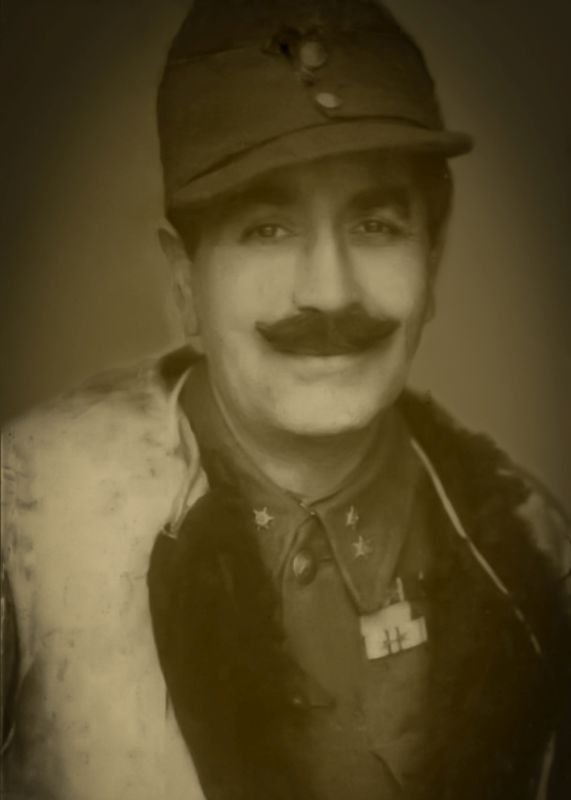
Endre Kovacs and the siege of Budapest 1945
Kovács Endre, as a First Lieutenant in Vannay László’s battalion, played a crucial role in the defense of Budapest. He was involved in organising and leading a company under extreme conditions of urban warfare. His leadership was essential in maintaining the morale of his troops during the Siege of Budapest, one of the most intense and tragic military engagements of the war. The recognition he received posthumously underscores his bravery and the significance of his role within the Hungarian defense.
After the war, he was executed by the Soviet-backed Hungarian authorities in 1949 due to his involvement in anti-communist activities. Kovacs is remembered as a complex figure in Hungarian history.
-
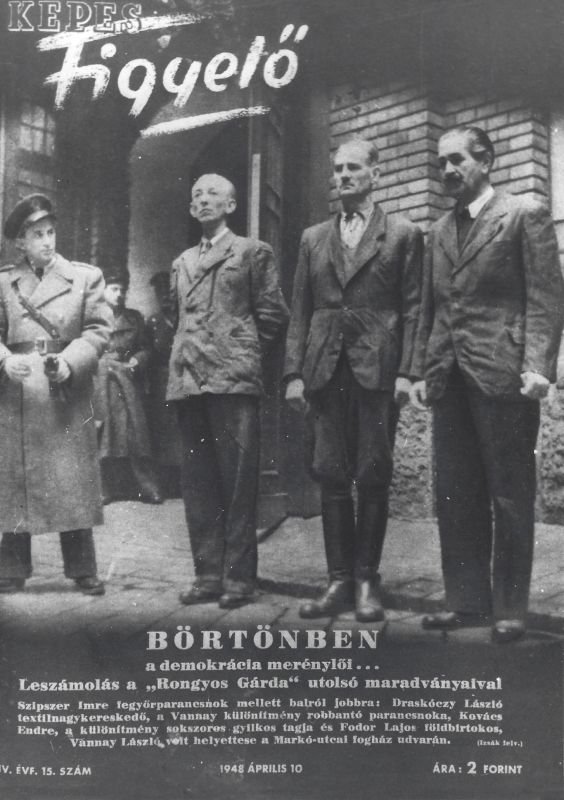
- Trial 1949 – Képes Figyelő, published on April 10, 1948, reports on their front page that the last remnants of the Rag Guard have been dealt with. (Kovács was sentenced to death, among other reasons, because during the 1938 uprising in the highlands a bridge guarded by a Czech unit was blown up together with soldiers.
Resources
- https://jeltelenul.hu/kovacs-endre
- https://kitores45.hu/katonahoseink/kovacs-endre-fohadnagy/#English
- Boy Soldier: The Defense of Budapest – Erwin Galantay
- www.eucharistzikuskongresszus.hu ,
- adatbazisokonline.mnl.gov.hu ,
- Dr. Ödön Málnási: Hungarian Martyrs p. 50,
- HM Institute of Military History and Museum Military History Archives HU MNL OL X 10874)
- Thanks to the specialists of the Military History Archives of the Institute and Museum of Military History of the Ministry of Defence no.: LEV/602-3/2024
- Military History Institute and Museum https://militaria.hu/en
- The Historical Archives of the Hungarian State Security (hereafter: Historical Archives or ÁBTL https://www.abtl.hu/english/) are listed below
- ÁBTL – 2.2.1. I/3. 8/1033.
- ÁBTL – 3.1.9. V-151578
- ÁBTL – 4.1. A-653/3. (page 270)
- ÁBTL. – 4.1. – A – 881. “Materials of ragamuffins, free troops, detachments”,
- ÁBTL. – 3.1.5. – O – 14850. “Ragged Guard”,
HM Institute and Museum of Military History Case File: HHI/276-2/2024.
- https://www.ket.hm.gov.hu/SitePages/Kezdolap.aspx
- https://www.familysearch.org/ark:/61903/3:1:S3HY-DRFJ-FL?view=index&personArk=%2Fark%3A%2F61903%2F1%3A1%3A64LM-RPW2&action=view
- https://web.archive.org/web/20150402123920
- http:/www.historia.hu/archivum/2006/0605_01.htm
- https://real.mtak.hu/85561/1/rongyosg%C3%A1rda%20II.%20r%C3%A9sz%20final.pdf
Attached documents: EPA02705_bortonugyi_szemle_2000_1_123-127_240226_011207 and EPA02705_bortonugyi_szemle_2000_1_123-127_240226_011207 ENGLISH
HM HADTÖRTÉNETI INTÉZET ÉS MÚZEUM
Hadtörténelmi Levéltár
1014 Budapest, Kapisztrán tér 2-4.
Postacím: 1250. Pf: 7.
Tel.: (36-1) 325-1676, Fax: (36-1) 325-1677
Andras Kovacs (son of Endre Kovacs 1901-1949) wrote
“My father was released from Soviet POW after 18 months weighing 45 kilos, and then in 1948, he was arrested by the AVO, and on March 31, 1949, he was executed by hanging, because, according to them, the time spent in the “Soviet paradise” was not enough for him to “expiate” his “war crimes”. May God reward him for his heroism.
The Zebike mentioned in the text is my nickname (András) given to me by my father.
I wish the blessing of the God of the Hungarians on the reader of these lines and I wish all of them a more beautiful, free Hungarian future.
András Kovács”
IAs the grandson with the same name Endre, I dedicate this biography of Lieutenant Kovács Endre (grandfather) and memory of Andras Gyula (dad) to my family and all Hungarian military patriots that had fallen in pre and post WW2.
Special Acknowledgment
I would like to acknowledge the help and support of Zsolt Alkay, “President of the Soldiers’ Grave Research and Care Association, a passionate Hungarian who documented many Hungarian solders involved in the Siege of Budapest in 1945. https://kitores45.hu/. My grandfather is covered in https://kitores45.hu/katonahoseink/kovacs-endre-fohadnagy/#English
